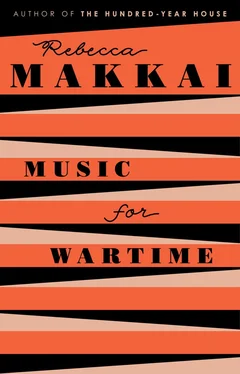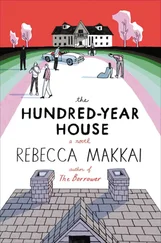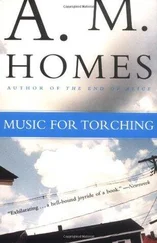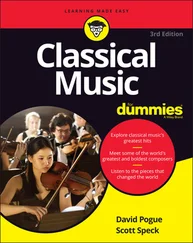
She walked up the stairs and brushed her teeth and looked out the bathroom window. There were no streetlights this far out in the country, and so no cross, no flowers. You’d never know anything was out there at all, beyond your own reflection on a glassy sheet of blackness. And what a reflection! She stared in bafflement at this bright-eyed stranger. There she was in the mirror, too, her pulse so fast and exuberant she could see it in her neck and temples. She scratched her cheek to see if it was sunburnt or just flushed.
Well, there were signs like crosses and runes and totems, and then there were the signs of the body. Those ones didn’t play fair, didn’t sit on your lawn and wait for interpretation. They hijacked you. Before her body could betray her any further, before it could carry her to Gregory’s door, she grabbed the shampoo from the side of the tub and squeezed a good quarter cup of green slime right on top of her head. She said out loud, “You’re not going anywhere like that.”
But the shower didn’t help, the ratty towel didn’t help. She put her clothes back on.
The lamplight under Gregory’s door. This stubborn and idiotic lust. Sometimes, after all, a thing wasn’t an omen but the event itself, as solid and irrefutable as an oak in the path of your little motorcycle.
She walked into the guest room and sat on the edge of Gregory’s bed. He closed his novel and tugged the sheet up to his armpits. He was bare-chested. “I bet your apartment doesn’t even have room for a cello,” she said. “You want to hear a cello every morning when you step out of the shower?”
“Yes. I want that very much.”
“You’re not going to take me out on a date first? And we might hate each other. Don’t you think it could ruin the quartet? It could.”
He held his hand out to her, palm up. It took her a moment to realize he wasn’t offering any answers but that.
And she took the hand, and he pulled her into the bed and under the covers, and even in the lamplit darkness, even as the whole house dissolved around them into the gray, ecstatic haze of two a.m., she was wide awake.
His mouth on her shoulder was warm. The universe flipped in on itself. She found the deep and hollow place where his neck became his chest.
GOOD SAINT ANTHONY COME AROUND
T he story goes that Chapman, leaving a meeting in Seattle — this was the seventies, he was still designing posters — looked up toward a noise in the sky and got hit in the face with a fish. No one saw, no one pointed and said, “Christ, man, that’s a fish!” but there it was, flailing on the cement. Up in the air, two cormorants still fought loudly. Chapman picked the thing up: a six-incher, cold and dense. He ran with it down the street, shouting at people in his way, dodging bikes. Around a corner and into a Vietnamese takeout place. “Cup of water!” he yelled. “Cup of water!” And when the woman didn’t understand, he grabbed a cup from the trash and filled it at the soda machine and dropped the fish in headfirst. Later he’d carry it to the ferry docks in a borrowed bucket and dump it back in the bay. The fish wasn’t doing well and would just be easy prey again, but what was he supposed to do, take it to a vet?
My point here isn’t that Chapman would do anything to help you out, although that’s true. My point is, he was the kind of guy stuff happened to. Some people live their whole lives according to the laws of probability. If there’s a one in six thousand chance of getting hit by lightning, they won’t. They won’t win the lottery, either. Because someone like Chapman will. Someone whose stars made strange and intricate patterns at the moment of his birth.

Chapman met Francisco Ling the same way he met many great artists of the late eighties: He knocked on his door one day and punched him. He’d had the idea over drinks with a friend. “I want to punch Keith Haring in the face,” he’d joked, and the friend had said, “Do it.” And somewhere along the way, the idea became serious, became the seed of a great photographic series: famous and influential artists, right after Chapman hit them in the face. Chapman would ring the doorbell, wait for the artist, and punch him square with his right hand, clicking the camera with his left in time to catch the artist’s shock, pain, blood. And if the artist fought back, Chapman kept clicking. He’d explain what he was doing, and — if you can believe it — most of the artists understood and forgave and were even flattered. The series was called anXiety of influence , and he would patiently explain its Oedipal undertones, its message of forceful reinvention. Aperture ran an article and Chapman let them publish his Haring photo (cowering, bewildered, bloody lip) and the Rauschenberg one (mouth agape, shouting) before the series was even complete. His reputation was made.
Was Chapman inspired by that fish hitting him ten years earlier? Possibly. Which is to say, we all became aware of the fish incident through the interviews surrounding his eventual solo show. Journalists would ask if he’d ever been surprised like that, if he’d ever been hit in the face, and he’d tell the story.
By the time he got to Francisco Ling in May of 1988, the Aperture article had run, there had been hot debate over Chapman’s decision not to hit women (chivalry, or a move to exclude them from the canon?), and Francisco Ling, looking through his peephole, recognized the guy.
He called, “I’m sick. You’re not hitting me today.”
“Okay,” Chapman said. “Can we stage something?”
So Ling opened his door onto the hallway of the Hotel Chelsea and saw the man rocking on his heels. Chapman’s beard and flannel shirt did nothing to make him look straight — they were almost an ironic gesture — and his eyes (the way Ling told the story) were wet and brown and strangely apologetic. Perhaps this was because, as soon as the door was open wide enough, he swung anyway and hit Ling in the nose.
Ling bent double, his mouth filling with blood. The camera clicked and clicked. Ling spat so he wouldn’t drool, and then he said, “I have AIDS.”
“I know.”
“Check your hand. Check that you didn’t cut your hand.”
Ling would later credit Chapman with not checking his hand at all, with saying, “Let me get you some ice.” Chapman would always maintain that he was just busy shooting the rest of the roll — sometimes the best shots came later — and thinking pragmatically that if he’d cut his hand, noticing sooner wasn’t going to make much difference.
They wound up on the couch in any event, Ling holding a Ziploc of ice chips to the bridge of his nose, Chapman drinking orange juice from a small glass. They talked about the heavy rain, about Ling’s new sculptures, about how he wanted, like Yves Klein, to patent his own color.
I told you Chapman was the kind of guy things happened to, and maybe what I mean in part is that he let things happen to him, let change wash over him. Because within a week, anyone who dropped by Ling’s found Chapman now living there, too, moving his stuff from the East Village one cardboard box at a time. In seven days, Chapman and Ling had settled into a quiet companionship that seemed built on thirty years’ intimacy.
Ling threw a party at the end of the month — or really the two of them did, as we discovered when we showed up, wine bottles in hand — the purpose of which was to announce their pairing to the world. It was nice for Ling, we conceded, even those of us who’d last seen Chapman when he hit us in the face, even those who still felt a pulsing in our cheekbones when it rained. Ling’s nose was bruised, and when Chapman leaned in to kiss him, we winced.
Читать дальше













